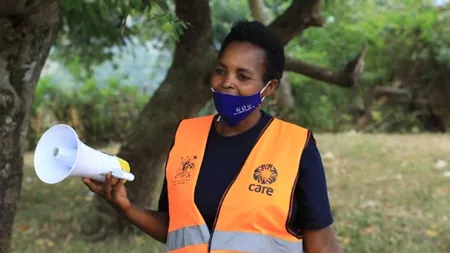“Before COVID, the community didn’t really pay attention to us. Now we have a lot of power to make change – when we talk, people listen. It’s completely changed how we are perceived and treated.” - Female health worker, Uganda
Despite years of chronic underinvestment, health workers around the world—70% of whom are women—have found ways to keep health systems running in COVID-19. By building on investments that came before COVID-19, women have found innovative ways to keep systems running, continuing – and sometimes increasing – health services during COVID-19 and other overlapping shocks to the health system.
To take just one example, 410 women in Bangladesh served 2.8 MILLON people. As independent social entrepreneurs with government certification, they worked to get services to the poorest people in their communities, and earn an income at the same time. They even got certification to become COVID-19 vaccinators and get vaccines to underserved districts.
What did women at the last mile do?
- Providing services and information. Women in savings groups in Myanmar used their own savings to become first responders and midwives during COVID-19 lockdowns so they could still get health services even when they couldn’t reach formal health services. They got polio vaccines to 80% of their communities. In Bangladesh, Skilled Health Entrepreneurs became certified vaccinators to get COVID-19 vaccines to the last mile and provided services for 2.8 million people. In Afghanistan, urban community health workers provided services out of their homes at the height of the COVID-19 lockdown so women could still access health care without fear of getting COVID-19 in hospitals. 41% of women in savings groups participated in sharing COVID-19 information in their communities to ensure COVID-19 prevention.
- Innovating with technology. In Syria, health workers used telemedicine consultations to provide sexual and reproductive health services, and increased family planning services to adolescents by 55%. In Cameroon, peer educators provided consultations and services for 32,076 HIV+ people in just 3 months, expanding services by 59% using WhatsApp, SMS, and other online platforms. In Ecuador, volunteers from refugee communities hosted online counseling sessions to connect people at high risk of contracting COVID-19 to case managers and health services. CARE and its partners were able to reach more than 5,131 people with vouchers that helped them access health services—and 55% of the vouchers went to support sexual and reproductive health care. In Tanzania, health workers provided free reproductive health counseling and referrals through 211,224 mobile phone calls
- Holding systems accountable. In Malawi, women and young people used Community Scorecards to advocate for an increase in the national budget for sexual and reproductive health, even as most countries were cutting those budgets to make room for COVID-19 response. In Niger, women in solidarity groups negotiated for lower rates for women’s services at health centers so that the economic impacts of COVID-19 didn’t prevent refugee and host women from getting the services they needed most.
- Building solidarity. In Colombia, women worked to get mental health services to health workers who were suffering from burnout and other impacts of COVID-19. In Tanzania, health workers focused on building trust with community members—especially young people—to ensure that people got services. Follow up for pregnant women improved by 68%. Family planning more than doubled overall, and quadrupled for adolescent girls. In the words of community health worker Esther Malisha “Us CHWs have been acting as a bridge between community and health facilities.” In Benin, women in savings groups supported adolescent brides and survivors of GBV to access health and legal services. That contributed to a 50% drop in early and forced child marriage rates and adolescent birth rates between 2018 and 2021.
How did it happen?
- Help build skills and confidence. Women and other people who are traditionally left out of power, opportunities, and decision-making need support to build their skills—everything from technical skills in health issues to business skills to literacy. Leadership and negotiation skills are a core part of the equation. All of that helped women build confidence to lead and find solutions to the problems they and their communities face.
- Reinforce networks and relationship. Coming together to solve problems has been a core ingredient to success for women at the last mile. Women who are in groups are 78% more likely to be involved in public decisions after they join the group.vi Women’s involvement in leadership has led to higher family planning budgets, health services at the last mile, and higher life expectancies. Women have leveraged all kinds of groups—from savings groups to health worker coalitions to community action groups focused on gender equality—to make health care available in crisis. Working with men and boys, leaders, and other people who control decisions is also critical to successfully improving health access.
- Invest in support structures. While women have worked together to create incredible solutions, they need systems that support equality. Everything from fair pay to access to leadership roles to accessible childcare to social norms that support women’s mobility and access to health care make it more likely that women can continue to provide resilience in health systems.
- Insist on gender equal pay and creative financing where required. In Bangladesh, the health workers are independent small business owners. In India, they are paid through formal government health systems. In West Africa, women in VSLAs made masks to protect from COVID and to earn an income. Right now, half of the work women do on health is unpaid, and when women are paid, they make 28% less than their male peers. We must do better.
- Invest early and consistently. Many of these successes built on more than 5 years of previous investments in skills building, leadership training, solidarity, and social norms work to support gender equality for health workers.
Want to learn more?
Check out the full report here.
